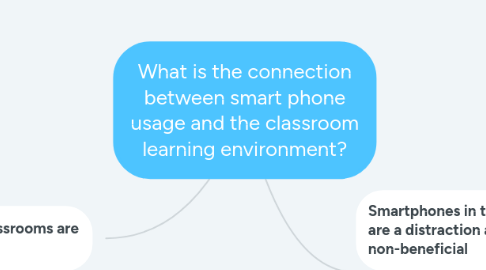
1. Smartphones in classrooms are beneficial
1.1. Although smartphones cost a lot of money, the benefits of that cost are the useful free apps that come with the smartphone (Maney).
1.1.1. In the article, Maney quoted a sentence from his research "In 1979, I remember dialing a number to get only the time and temperature, though that was free too" (Maney).
1.1.1.1. This means that smartphones can help a lot in the classroom, such as a calculator and clock.
1.1.2. In the article, it is also stated that "In 1979, you could buy a Kodak Pocket Instamatic camera, about the size of a deck of cards, for $28 ($92 now)" (Maney).
1.1.2.1. This means that smartphones have changed the way we live, now we don't have to buy disposable camera's.
1.2. Smartphones can help in classrooms and make learning easy, accessible, and beneficial (Soloway).
1.2.1. In the article, it's shown that "90 percent of what a student has to do, the smartphone can do it" (Soloway).
1.2.1.1. This makes me think that smartphones could potentially have a lot of good use in the classroom because, it can do everything the student has to do.
1.2.2. Soloway explains that "Smartphones make possible everywhere learning, all-the-time learning" (Soloway).
1.2.2.1. This matters because you can learn anywhere, like at work, the bus stop, a diner etc.
1.3. Because, smartphones are very expensive devices, but you get apps for free on the phones which are helpful and could also help in class.
1.4. Because, smartphones are small devices that are easy to use and everyone has access too which could help in school, as well as all the free apps that could be used in class.
2. Smartphones in the classroom are a distraction and non-beneficial
2.1. Smartphones as a way of learning for toddlers don't benefit them, but they slow down their learning process (Wapner).
2.1.1. In the article, Wapner states "In total, 20 percent of the children were spending nearly half an hour per day staring at a tiny touch screen by the time they were 18 months old" (Wapner).
2.1.1.1. This means that most toddlers who learn with smartphones, end up being attached to it.
2.1.2. A study conducted by the UT and the Hospital for Sick Children reports "The researchers saw no delays in gestures, body language or social interactions, but the ability to form sounds into words came slower among the phone holders" (Wapner).
2.1.2.1. This connects to the viewpoint, because the excerpt proves it by saying smartphones do slow down learning process'.
2.2. Smartphones may help, but when it comes to classroom learning, we probably shouldn't use them because of distractions that could be created (Smartphone Do Not Benefit).
2.2.1. According to the researcher of the Smartphones Do Not Benefit article, "Results showed that students who used laptops in class spent considerable time multitasking and that laptop use posed a significant distraction to both users and fellow students" (Smartphones Do Not Benefit).
2.2.1.1. This means that electronics don't help in the classroom, but they do distract students.
2.2.2. According to another study from the Smartphones Do Not Benefit article, "Texting students took longer to perform simple tasks such as reading a written passage than those who did not" (Smartphones Do Not Benefit).
2.2.2.1. This matters because it's saying that smartphones have a big effect on doing simple things, like reading a paragraph.
